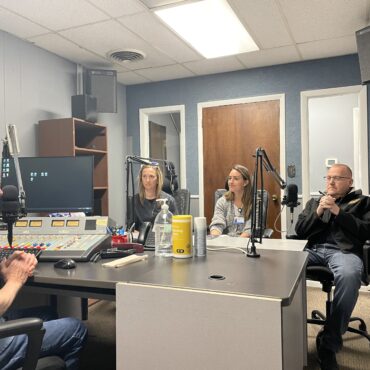Download Our Mobile App And Take WKTN With You . > > > > > > > > > > IT'S FREE!!

ADA, Ohio – Cadence. Lung capacity. Resonant language. Rhetorical impact. Rockstar ethos. Do you have what it takes to organize and lead a public protest against something as significant as racial injustice, human rights violations or gender inequality?
Dissent that affects change is anything but easy, as Ohio Northern University students will learn in Writing for Advocacy and Activism, a 2021 fall semester course to be taught by Bryan Lutz, Ph.D., assistant professor of rhetoric and composition. Inspired in part by powerful contemporary social justice movements such as Black Lives Matter, along with revolutionary historic movements such as those that championed sexual freedom and women’s suffrage, Lutz designed a timely and relevant learning experience. Persuasive communication methods that are participatory, democratic essentials will be highlighted. Producing well-researched written work and using outdoor voices will also be required.
Lutz expects the classroom atmosphere to be high-energy, interactive and inspiring.
Students will learn about the history of social justice movements and practice the kinds of writing used by movement advocates and activists. They also will explore the works associated with advocacy and activism, such as chants, policy briefs, flyers, press releases and social media posts. Rather than supporting particular movement stances, students will focus on the practical and rhetorical methods that movements use to impact society.
Additionally, Lutz intends for students to come away from the class with strengthened collective values and strategies for supporting and productively sustaining them within hospitable, volatile or even indifferent environments. Social transformation requires knowing how to peacefully but assertively further a cause or belief that individuals, groups or systems don’t agree with, sometimes in ways that could be considered offensive or disrespectful. Colin Kaepernick’s kneeling during the National Anthem exemplifies this concept. Systemic policies and behaviors are difficult to budge. So, which strategies are most likely to inspire change?
“There’s so much debate over the age-old sins of this country when it comes to racism, sexism and where those intersect with policing and such,” Lutz explains. “Those debates have been raging ever since the Civil Rights movement’s inception and long before that. But it’s also about asking what are the most appropriate ways to engage with systems of power and trying to change them.”
Many are confused about the cultural and identity shifts and clashes that have been happening in the U.S. in recent years, Lutz says. “I have lots of casual conversations with people who are trying to make sense of current events. It’s hard for the adults to figure out. Students have those same kinds of questions. They sort of feel helpless when they see a lot of people running the streets, they see people getting arrested, they see people getting gassed. I’m not even describing something far away—it happened in Columbus, Ohio.”
A typical default reaction for younger people, Lutz says, is to not discuss controversial topics with their peers. “There’s the polarization viewpoint of, ‘I don’t want to fight with my other classmates. I don’t want to find out who disagrees with me on this issue. I don’t want the classroom space to become perhaps like the same degree of unrest happening among the punditry or even on the street.’”
The Writing for Advocacy and Activism course will instead require discourse, and therefore a willingness to be adventurous. Participants will use research and discussion to critically examine perceptions about movements and their leaders and influencers from a variety of angles.
“Knowing the character of social movements and how the character is both defined by the groups that are part of the action, but also how it is defined by the folks who might be opposed to them, is important,” says Lutz. “There is always that tension and there’s always these efforts to discredit and say, ‘That’s somebody who’s violent, this is somebody who’s obstinate, this is somebody who is not willing to engage or make compromises.’ I don’t say that I have all the answers with regard to those things; some of it is an open question to be formed with students as well.”
Learning how to differentiate between activism and advocacy will also be prioritized in the course.
“Advocacy and activism are two words that often get conflated when they are totally distinct things,” Lutz says. “They’re distinct not only in their dictionary definitions but in the kind of character that an advocate must have compared to an activist, in the kind of purpose that they have for their communication and in the most common communications they employ. Nothing is a clear binary. There’s certainly overlap between the two. But if you look at them as two different persuasive purposes, it allows you to be more adapted to the kinds of situations that require them.”
Understanding those differences “also allows those with privilege to be a better ally,” Lutz notes. “Different marginalized groups have to advocate on their own behalf or do the kinds of activism, the kinds of consciousness-raising things, that help others be a better ally. The idea is not to try to shove one action into the box of another and vice versa.”
Lutz said his course design inspiration also comes from his personal involvement in social justice movements. “Teaching these topics is most squarely in my wheelhouse. I specialize in the kind of writing that advocacy and activist groups do to build an identity, solve problems, argue and act in the world. It’s writing that I’m most passionate about and that I can teach students,” he says.
What sorts of projects can students expect to complete? “One of the assignments will be an activist chant,” says Lutz. “I would like the students to get the opportunity to read about how chants are used in activist groups, how the language is chosen, how the melodies tend to borrow from other melodies… There’s a degree of rhyme and meter to it. The assignment will culminate in us coming up with our own activist chants about things we care about. This is the lesson I’m most excited about for the way it’ll get students engaged.”
Reading about chants is one thing, but actually creating one and leading others in such a performative manner is another. “I need students to experience that in a whole-body way,” Lutz says. “Raising your voice to that degree actually requires a lot of respiratory strength, sort of like being in a chorus and singing. You have to push from the diaphragm. You can’t push from your throat or you’ll be hoarse. You need to go for hours. Whoever leads that chant has to own it and have all kinds of character and energy to lead a large group.”
Authoring policy briefs, exploring myriad communication modes and considering audience will also distinguish the course. Policy briefs in particular will reveal how difficult it is to meld the textual with the visual in a quick, attention-grabbing way.
A policy brief distributor “will be someone who’s going to hand information to those in power as they’re walking down the hallway or on their way to their next meeting. The paper needs to be written and visually designed in ways that allow them to understand what’s being pitched quicky, to sell them on the idea, and to sell them on the benefits not only for them but for their constituents. There’s a lot of gestalt psychology behind the way we put this together effectively. There are a lot of professional writing conventions that allows us to write clearly and concisely,” Lutz says.
The communicative tools will only take one so far, however. “There’s a certain level of vulnerability you must embrace to be active and engaged,” Lutz says. “There is a moment where students are just going to have to make, or be empowered to make, strategic choices about what to do when they make themselves vulnerable in that way. Putting yourself out there in the public realm and taking a stand can be hard. But you come away with an entirely different, multifaceted perspective.”
Written by: WKTN Staff
Similar posts
Copyright WKTN-Home Town Media | Public File | FCC Applications | ADMIN | 112 N. Detroit Street, Kenton, OH 43326 | 419-675-2355


